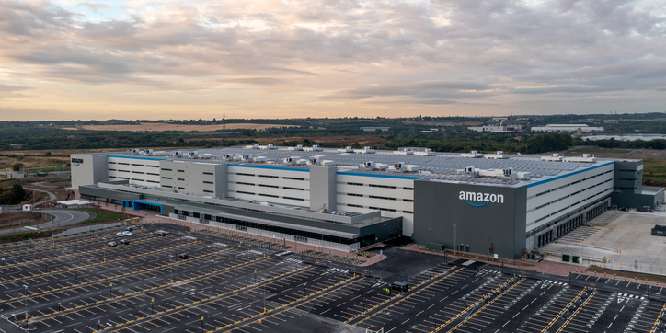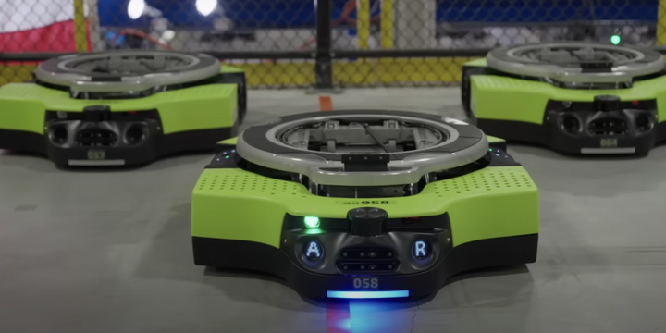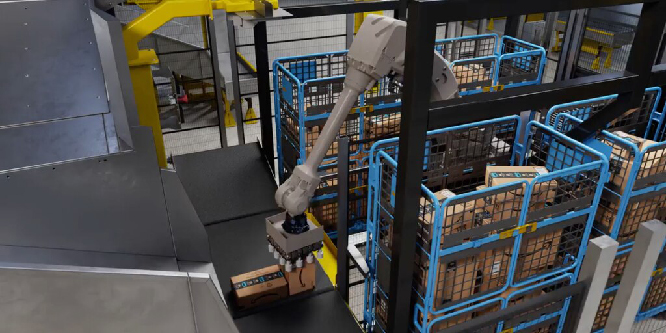
Photo: iStock: Teamjackson
Amazon Unveils New Fully Autonomous Mobile Warehouse Robots
Amazon has unveiled two new fully autonomous mobile warehouse robots, Proteus and Cardinal. The robots are designed to help Amazon employees move products more efficiently and safely in its fulfillment centers. But what do they look like and how are they expected to help?

First, we have Proteus, a large, rectangular robot that can carry up to 5,000 pounds of cargo. It is designed to move carts of products around the warehouse floor, freeing up employees to focus on other tasks. Proteus is powered by a battery and can travel up to 10 miles per hour.

Its counterpart, Cardinal, is a smaller, more agile robot that is designed to pick up and move individual packages. It uses artificial intelligence and computer vision to identify and pick up packages, and it can then transport them to their destination. Cardinal is also powered by a battery and can travel up to 5 miles per hour.
Both Proteus and Cardinal are designed to work safely alongside human employees. They are equipped with sensors that allow them to detect and avoid obstacles, and they have a slow-moving mode that allows employees to interact with them safely.
Amazon says that Proteus and Cardinal are still in the testing phase, but it plans to deploy them in its fulfillment centers in the coming months. The company believes that the robots will help to improve efficiency and safety in its warehouses, and it expects to deploy thousands of them in the future.
What Benefits Could These Robots Have?
The new robots from Amazon offer a number of benefits, including:
- Increased efficiency: The robots can help to move products more efficiently around the warehouse floor, freeing up employees to focus on other tasks.
- Improved safety: The robots are designed to work safely alongside human employees, and they are equipped with sensors that allow them to detect and avoid obstacles.
- Reduced costs: The robots can help to reduce the cost of labor in Amazon’s warehouses.
Still Room for Growth…
The new robots from Amazon also face a number of challenges, including:
- Integration: The robots will need to be integrated into Amazon’s existing warehouse infrastructure.
- Reliability: The robots will need to be reliable and able to operate safely in a warehouse environment.
- Acceptance: The robots will need to be accepted by Amazon employees.
In Conclusion…
The new robots from Amazon offer a number of potential benefits, but they also face some challenges. It remains to be seen how successful the robots will be in the long term. However, Amazon is clearly committed to the development of autonomous robots, and it is likely that we will see more of these robots in Amazon’s warehouses in the future.
Discussion Questions
DISCUSSION QUESTIONS: What are the potential benefits of using autonomous robots in warehouses? What are the challenges of using autonomous robots in warehouses?



The advantages of autonomous robots in warehouses are fairly obvious: efficiency, speed, reduced labor costs, possibly even accuracy, WHEN ALL ITEMS ARE IN STOCK AND IN THE EXPECTED BIN LOCATIONS. But the challenges to using these robots to the most effective degree will depend on in-stock position of all items, accurate put-away, and timely let-downs, limiting product damage, the ability of the retailer to plan warehouse replenishment accurately.
Bypassing the obvious performance and workforce benefits, one of the most critical advantages of robots is safety. Workplace injuries represent a huge drain on productivity and finances. They cause disabilities and are a substantial part of a warehouse’s insurance bill.
One downside of robots that shouldn’t be overlooked is the energy they use, although this is being addressed in a number of ways like regenerative drives.
It may take some time to fully integrate the new robots, but they will eventually become an established part of Amazon’s warehouse ecosystem. Like it or not, automation is the general direction of travel for fulfillment as it’s a labor intensive, expensive process that is ripe for disruption. Also, robots do not strike or form unions, which has been a problem for Amazon (and others). The issue, at least in the near-term, is return on capital. These robots will probably pay for themselves especially as margins on many Amazon products are reasonable. It’s a different story in a low margin sector like grocery where Ocado’s capitally intense automated solutions struggle with profitability.
Proteus and Cardinal are just the beginning. Let’s face it, robots are our future. Amazon will automate to gain speed, reduce labor costs, and increase its competitive advantages at every opportunity. Every retailer with the capital to automate should do so, and not at just at the five-mile-an-hour Cardinal pace.
The truth is, it’s only a matter of time before warehouses are fully automated. The benefits far outweigh the challenges. Yes, the unions will fight this tooth and nail, and Customer Fulfillment Centers (CFCs) and Micro-Fulfillment Centers (MFCs) have yet to fully take off. But they will as the price of people goes up and technology costs go down. It is an inevitable result. In the long run, few will be able to compete with Amazon, but without strategic automation, even fewer will survive to compete in this brave new world.
Robots can be quite useful in these situations. My concern, though, is that they are invested with almost magical powers – especially the idea of replacing the challenges of human management. Yet the costs of maintaining them and upgrading could outpace the costs of human employees. Worse, humans have abilities no robot could ever produce. I wish companies would spend more time pondering the mysteries needed to leverage human intelligence more than turning jobs into robotic action. Only then will we begin to release the true potential of human beings.
I suspect the warehouseman of the future will be more like the airline pilot with the plane on autoflight.
Back in 2003, my company was looking for 3PL operators to service retailers. We visited a number of warehouses that were fully automated.
Today the sophistication needed to service online businesses is leagues beyond what we needed back then. The point is that warehouse operators have been focussing on automated warehouses for decades.
In five years or less, there will not be a job called “warehouseman”. If a warehouse is not fully automated, the facility will not be able to compete.
Injuries and longer-term chronic ailments are a concern of every warehouse worker. Gaining acceptance of the robots will occur if people see them ass helping them in their jobs, enhancing what they do, and enjoyable. Everyone who first walks in a warehouse wants to use the forklift rather than move boxes by hand. A conveyer belt is much better than walking back and forth. But something that is perceived only as a replacement is viewed with disdain, only good for corporate, and not for them.
Interesting to read yesterday that Amazon could be a buyer for Ocado, one of several warehouse automation vendors who deploy a “hive” concept. That means the bin spaces are densely packed so only the robots can store and retrieve items.
The warehouse robots described here are designed to move and work in spaces designed for human access.
Which concept will prevail? I’d propose that the retro-fits will help improve performance of existing D.C.s, while built-for-bots installations will displace those over time.
Autonomous robots have some significant advantages for warehouse, automation, and safety. The moving around of heavy pallets can be dangerous, and also highly inefficient when done by employees. Robots can manage a heavier weight and coordinate with other robots and people to improve safety. This represents a significant artificial intelligence, machine learning challenge, but I’m sure Amazon will figure this out with time. The introduction of autonomous robots will definitely result in a decrease in warehousing jobs for the company, the question is just how much.
This ultimately is a big win for Amazon in efficiency, time, labor savings, and even real estate costs. Tech partner Nvidia has been working to make robot usage a reality, but also in how warehouse design and space allocation can make the facilities more productive.
And yes, this can even be a win for the smaller teams of warehouse workers on site, in that they can feel safer, and less extreme strain in sweltering heat. But robots aren’t perfect 100% of the time, and so human workers will still be needed to ensure operations are running smoothly.
This was going to happen, if not by Amazon, someone else. I am sure there will be many “lessons learned” here and I am eager to see how this goes for Amazon!
In my opinion, all fulfillment centers, dark stores, or warehouses have specific SOPs with a tightly regulated environment. Humans might not always find working under such circumstances enjoyable, which is why ‘Robots’ serve as a great alternative in such situations. While humans may experience restlessness at some point, robots will find it far easier to operate for lengthy periods of time with nothing but a fully charged battery. The “picking” part of logistics is the one challenge for Amazon in employing autonomous robots as it still requires some human involvement. However, I am certain that even this issue will be resolved with robotics.
Amazon being a major tech company, has a clear motivation of making substantial investments in this area due to the magnitude of its commercial operations. They have a strong reputation for developing innovative technology for large-scale operations. If these investments prove successful, Amazon may even offer the technology to other companies for their own utilization. Ultimately, this is great news that I believe will revolutionize the industry.
These innovations improve the employee experience and productivity. Protecting worker safety directly addresses issues raised in employee protests and unionization efforts.
A big challenge is if workers view the tech as a threat to their jobs (vs. empowering tools).
Amazon has taken a positive stride towards furthering its presence in the robotics industry, particularly in the warehouse space. This is not their first foray into this field, as they have previously experimented with robotics and acquired companies like Ocado when it made sense. It’s a smart approach to continually explore new technologies and find ways to improve their operations. The fact that they have invested time in addressing issues related to coexisting with their robotic counterparts indicates that they have overcome any scaling-related challenges. If there were any major obstacles, we would have likely heard about them by now. Amazon has a track record of effectively testing, learning and adapting its technologies.
Amazon’s new autonomous robots will be extremely useful in providing more visibility into what’s working in the warehouse, and what needs to be improved upon. In particular, these robots can be used to analyze how long it takes to complete certain tasks, and quickly identify and fix potential inefficiencies that are causing delays. On the other hand, I do foresee some hesitation from current and prospective Amazon employees around the use of robots in Amazon’s warehouses. So many people are worried about their jobs being replaced by robots or AI, it will likely take some time for employees to become comfortable working side-by-side with them, and may actually deter people from wanting to work at the company short-term.